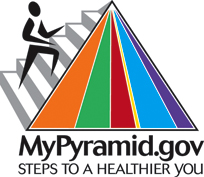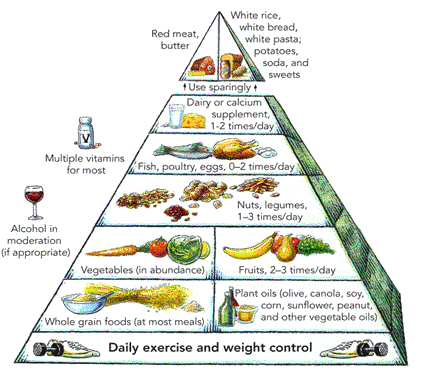
Donabee.com Health & Wellness

|
|
|
|
What Should You
Really Eat? More than a decade ago, the U.S. Department of Agriculture created a powerful and enduring icon - the Food Guide Pyramid. This simple illustration conveyed in a flash what the USDA said were the elements of a healthy diet. The Pyramid was taught in schools, appeared in countless media articles and brochures, and was plastered on cereal boxes and food labels. Tragically, the information embodied in this pyramid didn't point the way to healthy eating. Why not? Its blueprint was based on shaky scientific evidence, and it barely changed over the years to reflect major advances in our understanding of the connection between diet and health. With much fanfare, the USDA recently retired the old Food Guide Pyramid and replaced it with MyPyramid, a new symbol and "interactive food guidance system." The new symbol is basically the old Pyramid turned on its side. The good news is that this dismantles and buries the flawed Pyramid. The bad news is that the new symbol doesn't convey enough information to help you make informed choices about your diet and long-term health. And it continues to recommend foods that aren't essential to good health, and may even be detrimental in the quantities included in MyPyramid. As an alternative to the USDA's flawed pyramid, faculty members in the Harvard School of Public Health built the Healthy Eating Pyramid. It resembles the USDA's in shape only. The Healthy Eating Pyramid takes into consideration, and puts into perspective, the wealth of research conducted during the last ten years that has reshaped the definition of healthy eating. Pyramid Building In the children's book Who Built the Pyramid?,(1) different people take credit for building the once-grand pyramid of Senwosret. King Senwosret, of course, claims the honor. But so does his architect, the quarry master, the stonecutters, slaves, and the boys who carried water to the workers. The USDA's MyPyramid also had many builders. Some are obvious - USDA scientists, nutrition experts, staff members, and consultants. Others aren't. Intense lobbying efforts from a variety of food industries also helped shape the pyramid. In theory, the USDA pyramid should reflect the nutrition advice assembled in the Dietary Guidelines for Americans. According to the USDA, the guidelines "provide authoritative advice for people two years and older about how good dietary habits can promote health and reduce risk for major chronic diseases." This document, which by law must be revised every five years, aims to offer sound nutrition advice that corresponds to the latest scientific research. The panel assembled to create the guidelines usually generates 100 or so pages of dense nutrition-speak. This document is translated into a reader friendly brochure aimed at helping the average person choose a balanced and healthy diet. Of far greater importance, the Dietary Guidelines for Americans set the standards for all federal nutrition programs, including the school lunch program, and helps determine what food products Americans buy. In other words, the guidelines influence how billions of dollars are spent each year. So even minor changes can hurt or help a food industry. According to federal regulations, the panel that writes the dietary guidelines must include nutrition experts who are leaders in pediatrics, obesity, cardiovascular disease, and public health. Selecting the panelists is no easy task, and is subject to intense lobbying from organizations such as the National Dairy Council, United Fresh Fruit and Vegetable Association, Soft Drink Association, American Meat Institute, National Cattlemen's Beef Association, and Wheat Foods Council.(2) (We have the best government that money can buy, and they are soooo objective. HUGE money has been spent to influence this government release. Your health is the last thing to be considered. God forbid that an official source would say that drinking soda pop, eating red meat, drinking milk, etc. is bad for your health.) Dietary
Guidelines, 2005 Released in early January, 2005, the Dietary Guidelines for Americans 2005 continues to reflect the tense interplay of science and the powerful food industry. Several of the new recommendations represent important steps in the right direction:
Others remain mired in the past:
The USDA Pyramid Brick by Brick Distilling nutrition advice into a pyramid was a stroke of genius. The shape immediately suggests that some foods are good and should be eaten often, and that others aren't so good and should be eaten only occasionally. The layers represent major food groups that contribute to the total diet. MyPyramid tries to do this in an abstract way, and fails. Six swaths of color sweep from the apex of
MyPyramid to the base: orange for grains, green for vegetables, red
for fruits, a teeny band of yellow for oils, blue for milk, and
purple for meat and beans. Each stripe starts out as the same size,
but they don't end that way at the base. The widths suggest how much
food a person should choose from each group. A band of stairs
running up the side of the Pyramid, with a little stick figure
chugging up it, serves as a reminder of the importance of physical
activity. MyPyramid contains no text. According to the USDA, it was "designed to be simple," and details are at MyPyramid.gov. Unless you've taken the time to become familiar with the Pyramid, though, you have no idea what it means. Relying on the Web site to provide key information - like what the color stripes stand for and how many servings of each food group are recommended each day - guarantees that the millions of Americans without access to a computer or the Internet will have trouble getting these essential facts. The USDA also chose not to put recommended numbers of servings on the new Pyramid because these differ from individual to individual according to weight, gender, activity level and age. Instead, it offers personalized Pyramids at MyPyramid.gov. If the only goal of the Food Guide Pyramid is to give us the best possible advice for healthy eating, then it should be grounded in the evidence and be independent of business. Instead of waiting for this to happen, nutrition experts from the Harvard School of Public Health created the Healthy Eating Pyramid. It is based on the best available scientific evidence about the links between diet and health. This new pyramid fixes fundamental flaws in the USDA pyramid and offers sound information to help people make better choices about what to eat.
The Healthy Eating Pyramid sits on a foundation of daily exercise and weight control. Why? These two related elements strongly influence your chances of staying healthy. They also affect what and how you eat and how your food affects you. The other bricks of the Healthy Eating Pyramid include:
Other Alternatives The Healthy Eating Pyramid summarizes the best dietary information available today. It isn't set in stone, though, because nutrition researchers will undoubtedly turn up new information in the years ahead. The Healthy Eating Pyramid will change to reflect important new evidence. This isn't the only alternative to the USDA's MyPyramid. The Asian, Latin, Mediterranean, and vegetarian pyramids promoted by Oldways Preservation and Exchange Trust are also good, evidence-based guides for healthy eating. The Healthy Eating Pyramid takes advantage of even more extensive research and offers a broader guide that is not based on a specific culture. The Healthy Eating Pyramid is described in greater detail in Eat, Drink, and Be Healthy: The Harvard Medical School Guide to Healthy Eating, published by Simon and Schuster (2001). Failing The Test A few years ago, the USDA's Center for Nutrition Policy and Promotion created the Healthy Eating Index "to measure how well American diets conform to recommended healthy eating patterns."(4) This score sheet uses five elements from the longstanding USDA Food Guide Pyramid (number of daily servings of grains, vegetables, fruits, meat, and dairy products) and five from the 1995 Dietary Guidelines for Americans (total fat in the diet, percentage of calories from saturated fat, cholesterol intake, sodium intake, and variety of the diet). A score of 100 means following the federal recommendations to the letter while a score of 0 means totally ignoring them. To see how well the principles embodied in the Healthy Eating Pyramid stacked up against the government's advice, Harvard School of Public Health researchers created an Alternate Healthy Eating Index with a scoring system similar to the USDA's index. They then used information about daily diets collected from more than 100,000 female nurses and male health professionals taking part in two long-term studies to complete both indexes. Men who scored highest on the USDA's Healthy
Eating Index (meaning their diets most closely followed federal
recommendations) reduced their overall risk of developing heart
disease, cancer, or other chronic disease by 11% over 8-12 years of
follow-up compared to those who scored lowest. Women who most
closely followed the government's recommendations were only 3% less
likely to have developed a chronic disease.(5) In comparison, scores on the Alternate Healthy
Eating Index did appear to correlate with disease. Men with high
scores (those whose diets most closely followed the guidelines in
the Healthy Eating Pyramid) were 20% less likely to have developed a
major chronic disease than those with low scores. Women with high
scores lowered their overall risk by 11%. Men whose diets most
closely followed the Healthy Eating Pyramid lowered their risk of
cardiovascular disease by almost 40%; women with high scores lowered
their risk by almost 30%. "The new USDA dietary pyramid is a lost opportunity to help Americans make informed choices about diet and long-term health," says Walter Willett, the Fredrick John Stare Professor of Epidemiology and Nutrition in the Departments of Nutrition and Epidemiology. "It's clear that we need to rebuild the pyramid from the ground up, not just tip it on its side and dress it up with new colors. Every American deserves it." References 1. Hooper M, Heighway-Bury R. Who Built the
Pyramid? Cambridge, Mass.: Candlewick Press, 2001. |
![]()
© 2007 Donabee.com - All Rights Reserved Last updated on Monday, November 19, 2007


